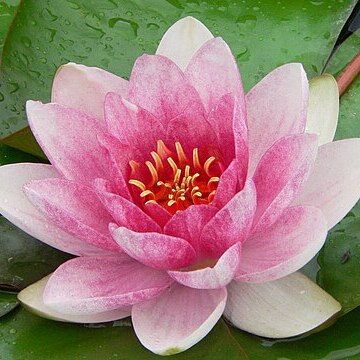Rhizomes erect, unbranched. Leaf blade cordate-ovate to ovate-elliptic, 5--12 × 3.5--9 cm, papery, abaxially glabrous, scarcely peltate, base deeply cordate and basal lobes parallel to contiguous, margin entire. Flower floating, 3--6 cm in diam. Calyx insertion on receptacle prominently tetragonous; sepals broadly lanceolate to narrowly ovate, 2--3.5 cm, obscurely veined, persistent. Petals 8--15(--17), white, broadly lanceolate, oblong, or obovate, 2--2.5 cm, transition to stamens gradual. Filament of inner stamens wider than anther, connective apically unappendaged. Carpels completely united, walls between locules of ovary single. Stigma rays 5--8(--10); carpellary appendages ovate. Fruit globose, 2--2.5 cm in diam. Seeds ellipsoid, 2--3(--4) mm, smooth. Fl. Jun--Aug. 2n = 112.
Rhizome erect, the petioles and peduncles arising near the tip; lf-blades commonly 7–12 cm long, two-thirds to three-fourths as wide, with a fairly open sinus; fls white, inodorous, relatively small, mostly 4–8 cm wide, opening in the afternoon; sep 2–3 cm, the receptacle quadrangular at the level of their insertion; pet 8–17; stamens mostly 20–40; stigmatic lines 6–9; sep becoming stiffly erect, not arched over the fr. Cold ponds and lakes; Me. and Ont. to n. Mich. and n. Wash., and northward; also in Eurasia. Summer. (C. leibergii)
A herb. It grows in water. The rhizomes or underground stems are erect and unbranched. The leaf blade is heart shaped to oval and 5-12 cm long by 3.5-9 cm wide. It is papery. It is smooth underneath. The base is deeply heart shaped and the lobes at the base are parallel or almost touching. The flower is floating. It is 3-6 cm across. The connection to the receptacle is 4 sided. There are 8-15 petals which are white. The fruit is round and 2-2.5 cm across. The seeds are narrowly oval and 2-3 mm long. They are smooth.


